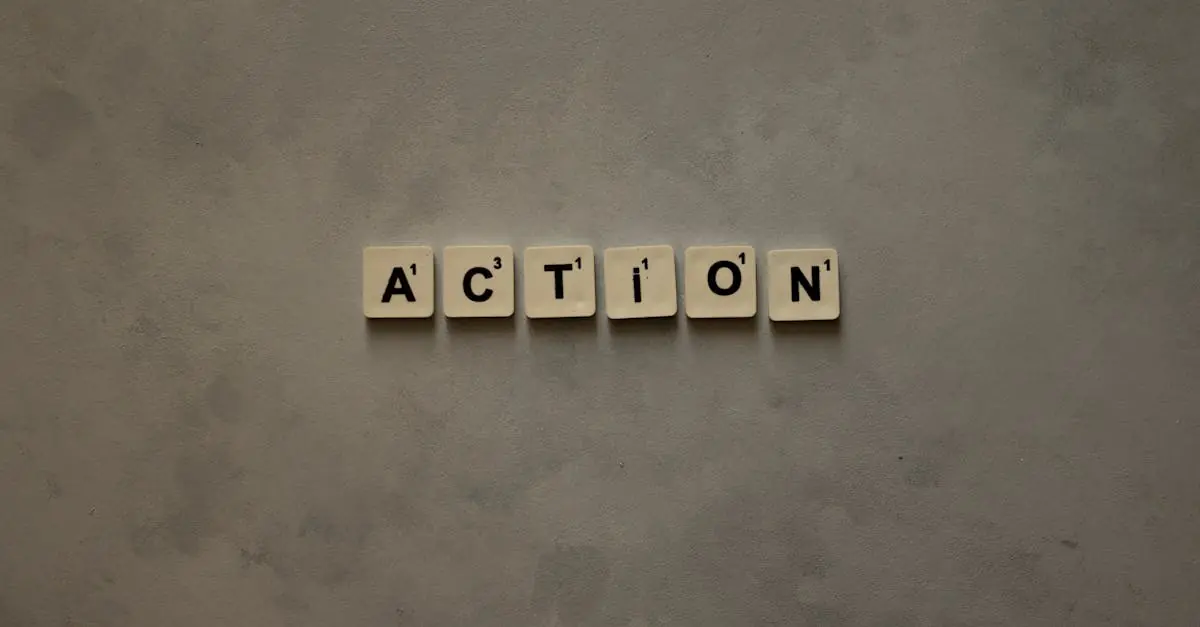In a world where the mundane often reigns supreme, unleashing creativity can feel like trying to find a unicorn in a haystack. Yet, creativity isn’t just for artists or dreamers; it’s a vital skill that can elevate problem-solving and innovation in any field. Whether you’re brainstorming a new marketing campaign or trying to cook dinner with ingredients that seem to be auditioning for a survival show, creative thinking strategies can make all the difference.
Table of Contents
ToggleOverview of Creative Thinking Strategies
Creative thinking strategies encompass various techniques designed to enhance innovative thinking and problem-solving abilities. Brainstorming encourages free-flow thought generation, allowing individuals to explore a wide range of ideas without restraint. Mind mapping facilitates visual representation of concepts, connecting related ideas and fostering deeper understanding.
Divergent thinking promotes the exploration of multiple solutions to a problem, moving away from conventional responses. Using this approach, individuals generate diverse concepts, expanding their perspectives. Analogical thinking draws parallels between unrelated topics, helping to inspire fresh insights through comparison.
Role-playing enables participants to immerse themselves in different perspectives, enhancing empathy and promoting creative solutions. This strategy fosters an open environment where unique ideas emerge. Embracing constraints can also stimulate creativity, as limitations force individuals to think outside the traditional frameworks.
Incorporating collaborative efforts, creative teams benefit from combining multiple viewpoints and skills, leading to richer idea development. Setting aside time for reflection encourages personal thought processes, further improving creative expression. Encouraging a playful mindset can enhance openness to imaginative ideas and unexpected solutions.
Understanding and applying these strategies can greatly improve one’s ability to tackle problems creatively across various fields, from business initiatives to culinary experiments. The effective implementation of multiple strategies can yield innovative results, making creative thinking an essential skill in today’s dynamic world.
Importance of Creative Thinking
Creative thinking enhances problem-solving abilities and fosters innovation in various contexts. Its significance extends beyond artistic endeavors.
Benefits in Personal Development
Personal development gains momentum with creative thinking. Individuals enhance their self-awareness by exploring diverse perspectives. Creative strategies encourage resilience in facing challenges. They empower individuals to generate unique solutions and embrace new experiences. Using these strategies also boosts confidence, as individuals recognize their creative potential. Engaging in creativity nurtures critical thinking skills. Positive self-reflection becomes more accessible, leading to personal growth.
Benefits in Professional Growth
Professional growth thrives on creative thinking. Organizations benefit significantly when employees think outside the box. Using creative strategies fosters innovation, leading to competitive advantages. Teams that engage in brainstorming generate a wealth of ideas, improving collaboration. Problem-solving becomes more efficient through creative approaches, positively impacting productivity. Businesses leverage creative thinking to adapt to market changes. Enhanced customer satisfaction arises from innovative solutions tailored to client needs. Retraining employees with creative techniques opens pathways to career advancement.
Common Creative Thinking Strategies
Creative thinking strategies empower individuals to generate innovative ideas and solutions. These methods promote free expression and exploration of diverse perspectives.
Brainstorming Techniques
Brainstorming techniques involve generating a list of ideas in a collaborative environment. Participants share their thoughts without judgment, allowing creativity to flow freely. Ideas can be built upon, leading to more refined concepts. Encouraging divergence in thought fosters unexpected outcomes and enhances overall creativity. Utilizing tools like sticky notes or digital platforms can enhance organization and visibility of ideas. Setting a defined time limit often encourages participants to think quickly and generate more ideas.
Mind Mapping
Mind mapping serves as a visual-thinking tool that organizes information hierarchically. Central concepts appear in the center, with branches connecting related ideas and subtopics. This approach clarifies relationships between ideas, enhancing understanding and retention. Color coding and images can enrich the map, making it engaging. Mind mapping invites more thorough exploration of topics and aids in structuring complex information. Flexible and dynamic, this technique adapts to various contexts and can easily accommodate changes in thought.
SCAMPER Method
The SCAMPER method focuses on improving or reinventing existing ideas through seven action-oriented prompts: Substitute, Combine, Adapt, Modify, Put to another use, Eliminate, and Reverse. Each prompt encourages deeper investigation of a concept’s potential. This method cultivates innovative thinking by challenging individuals to rethink assumptions. By systematically applying each prompt, users can uncover hidden opportunities. SCAMPER facilitates structured, yet creative, exploration of problems and stimulates collaborative discussions. This versatility makes SCAMPER suitable for diverse industries and projects.
Advanced Creative Thinking Techniques
Advanced creative thinking techniques enable individuals to approach problems from unique angles. Two prominent strategies include lateral thinking and design thinking, both of which foster innovative solutions.
Lateral Thinking
Lateral thinking encourages unconventional problem-solving. Instead of traditional, linear approaches, individuals explore alternative pathways to reach conclusions. This technique promotes generating ideas that seem illogical at first. Seeking unexpected connections between disparate ideas often uncovers surprising solutions. Techniques such as provocation and random input stimulate this method. Practitioners use these to step outside conventional constraints, leading to breakthroughs.
Design Thinking
Design thinking emphasizes empathy and user-centered approaches. It involves understanding users’ needs before developing solutions. This iterative process progresses through stages: empathize, define, ideate, prototype, and test. Each phase encourages collaboration and feedback, refining ideas through actionable insights. By prioritizing user experience, teams create innovative products and services that address real-world challenges. This method enhances creativity within organizations, fostering an environment ripe for innovation.
Implementing Creative Thinking Strategies
Implementing creative thinking strategies involves fostering environments and practices that stimulate innovation and collaboration.
Creating a Stimulating Environment
A stimulating environment enhances creativity. Natural light, vibrant colors, and open spaces often lead to increased inspiration. Flexibility in workspaces allows for movement and interaction, promoting fresh ideas. Personal touches like artwork and plants can contribute to a relaxed atmosphere, encouraging free thinking. Engaging tools, such as whiteboards or creative software, provide platforms for idea generation. Setting aside time for unstructured brainstorming also allows for spontaneous thought flows. Incorporating regular breaks helps recharge the mind, leading to clearer perspectives. Ultimately, the right environment can significantly elevate the creative process.
Encouraging Collaborative Practices
Collaborative practices amplify creative thinking. Diverse teams bring varied viewpoints, enhancing problem-solving capabilities. Regular team brainstorming sessions facilitate idea sharing, fostering a sense of ownership among team members. Utilizing digital collaboration tools enables remote teams to connect seamlessly, exchanging ideas in real time. Encouraging open communication creates an atmosphere of trust, essential for innovative thought. Celebrating team successes reinforces positive collaboration, motivating individuals to contribute more freely. Structuring workshops focused on design thinking or other methodologies enhances group creativity by guiding discussions toward common objectives. Emphasizing these practices can unlock new levels of creativity within teams.
Creative thinking strategies are invaluable assets in today’s fast-paced world. They empower individuals and teams to navigate challenges with innovative solutions. By embracing techniques like brainstorming and design thinking, one can unlock new perspectives and ideas.
Fostering a stimulating environment and encouraging collaboration can significantly enhance creativity. As organizations adapt to evolving market demands, leveraging these strategies becomes essential for sustained success. Ultimately, cultivating creative thinking not only drives personal growth but also propels professional achievements, making it a cornerstone of effective problem-solving and innovation.

